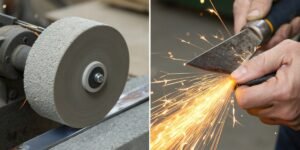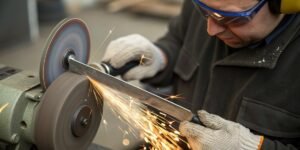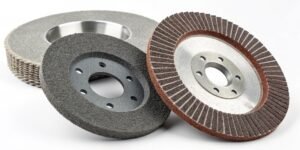
Trying to clean or prep a surface with the wrong media? This common mistake can ruin your part, create health hazards, and completely waste your time, leaving you with a worse problem than you started with.
Modern sandblasting uses a variety of engineered abrasives. The choice depends on the job, but common media include aluminum oxide, glass beads, steel shot, and silicon carbide. [1, 5, 6] Using actual sand is now highly restricted due to health risks. [2, 3]

My insight on this comes from a deep understanding of how materials interact. The sandblasting process is about using a high-speed stream of particles to impact a surface. The goal is to clean it or make it rougher for better coating adhesion. It can be done dry, which is fast and covers large areas but creates a lot of dust. Or it can be done wet, which is cleaner and more precise but less efficient. At our factory, Reliable (RL), we supply the core materials for these processes. We know that the abrasive itself is the most important choice. It defines the speed, the finish, and the safety of the entire operation.
What abrasive to use for sandblasting?
Facing a wall of abrasive options and not sure which to pick? Choosing wrong can be costly, either by damaging delicate parts with aggressive media or by failing to clean a tough surface with media that is too soft.
Match the abrasive to your material and goal. Use steel grit for aggressive rust removal, aluminum oxide for surface profiling, glass beads for gentle cleaning and polishing, and organic media like walnut shells for delicate surfaces. [1, 6, 8]

To choose the right abrasive, you have to answer two questions: What material am I blasting, and what result do I want? Are you stripping thick rust from industrial steel or cleaning a sensitive aluminum engine part? Your choice of media will change completely. Steel grit is cheap and aggressive, perfect for heavy scale on steel. Aluminum oxide is the amazing all-around performer; it’s hard enough to create an anchor profile for paint but controllable enough for many surfaces. Glass beads are completely different; they are used for peening or cleaning, leaving a smooth, satin finish rather than an etched one. For very delicate jobs, like cleaning molds or circuit boards, soft abrasives like walnut shells1 or plastic beads are used. They can remove coatings without damaging the underlying substrate.
| Abrasive Media | Hardness (Mohs) | Shape | Primary Use |
|---|---|---|---|
| Aluminum Oxide | 9 | Angular | Surface profiling, rust/paint removal. [4, 6] |
| Glass Beads | 5.5 – 6 | Round | Cleaning, peening, creating a satin finish. [8] |
| Steel Grit/Shot | 8 | Angular/Round | Heavy rust and scale removal, peening. [1, 9] |
| Silicon Carbide | 9.5 | Angular | Fast cutting on very hard surfaces. [1] |
| Walnut Shells | 3 – 4 | Angular | Gentle cleaning of delicate parts. [8] |
Why is sand blasting forbidden now?
Have you heard that "sandblasting" is banned and are worried about the legality? This common confusion stems from a critical misunderstanding about what makes the process dangerous, causing people to fear the method instead of the material.
Using actual "sand" (crystalline silica) for abrasive blasting is forbidden or strictly regulated in most countries. [2, 3] This is because blasting breaks it into fine dust that, when inhaled, causes silicosis, an incurable and often fatal lung disease. [3, 7]

The term "sandblasting" has stuck around, but the practice of using sand has not. The danger is very real and very serious. The problem is a component in natural sand called crystalline silica2. When you blast with this sand, the high-velocity impact shatters the sand particles into microscopic dust. This respirable crystalline silica is so fine that it gets deep into your lungs and stays there. Your body cannot remove it. Over time, it causes scar tissue to form, leading to a condition called silicosis, which makes it progressively harder to breathe. [3, 7] There is no cure. Because of this severe health risk, organizations like OSHA in the United States have created strict regulations that effectively ban the use of high-silica content sand as an abrasive when safer alternatives are available. The process itself is fine; it’s just the sand that had to go.
Which material is commonly used as the abrasive in sandblasting?
Now that you know you cannot use sand, what is the new industry standard? For business buyers, you need a reliable, cost-effective, and versatile abrasive that can handle the widest range of jobs without causing health issues.
Aluminum oxide is one of the most common and versatile sandblasting abrasives used today. [1, 4] Its excellent hardness, recyclability, and ability to create a consistent surface profile make it the go-to choice for a huge variety of industrial applications. [4, 6]

As a company that produces a wide range of abrasives, we see what the global market demands. Aluminum oxide is a top performer. It hits the sweet spot for many of our B2B customers. With a hardness of about 9 on the Mohs scale, it’s tough enough to quickly strip rust, paint, and scale from most metals. Its angular shape is perfect for etching the surface, creating an "anchor pattern" that helps paint, powder coatings, and other finishes adhere much more strongly. [4] Crucially for cost control, aluminum oxide is also very tough. It resists shattering upon impact, which means you can collect it, clean it, and reuse it several times, lowering your overall media cost. While steel shot3 might be used for heavy structural steel and glass beads4 for finishing, aluminum oxide is the versatile workhorse for surface preparation.
What is a cheap alternative to sand blasting?
Is the high cost of professional blasting equipment stopping your project? You need a clean surface for your manufacturing process, but you cannot justify the investment in a full blasting cabinet and compressor setup for smaller jobs.
Cheaper alternatives to sandblasting include manual or power wire brushing, sanding with an angle grinder, or using chemical strippers. For less aggressive cleaning, soda blasting is also an option. [10] Each method is more labor-intensive and less uniform than abrasive blasting.

While nothing truly replaces the clean, profiled surface from a proper abrasive blaster, there are other ways to get the job done on a budget. Power wire wheels or cups on an angle grinder5 can remove loose rust and paint but can also polish the metal underneath, which is bad for paint adhesion. Sanding with a coarse flap disc is another option we know well. It is very fast for removing material but can generate a lot of heat, potentially warping thin metal, and it does not leave a uniform profile. Chemical strippers are effective at removing paint but are messy, involve hazardous materials, and do nothing to remove rust or profile the metal itself. Soda blasting is a gentler form of blasting that cleans and degreases but does not create an anchor pattern for coatings. These alternatives can work, but they all require more manual labor and provide a less ideal surface for industrial coatings.
Conclusion
Modern "sandblasting" relies on safe, engineered media like aluminum oxide, not hazardous sand. Choosing the right abrasive is critical for performance, and while cheaper methods exist, abrasive blasting provides the superior surface preparation for professional applications.
-
Understand how walnut shells serve as a gentle abrasive for delicate cleaning tasks. ↩
-
Learn about the health risks associated with crystalline silica and why it’s banned in many applications. ↩
-
Discover the effectiveness of steel shot for heavy rust removal and its role in industrial applications. ↩
-
Learn how glass beads provide a gentle cleaning option and create a smooth finish in various applications. ↩
-
Explore the versatility of angle grinders in removing material and preparing surfaces. ↩
Written by
leeon
You may also be interested in:

What's the application of CBN Wheels?
Struggling with grinding hard steels? Frequent wheel changes and poor finishes can hurt your bottom line. We have found that CBN wheels provide the durability

What is the difference between grinding and honing a blade?
A dull blade is a frustrating problem. It slows down production and ruins your workpiece. Using the wrong technique to fix it can cause permanent

How to sharpen a knife on a bench grinder?
Is your dull knife slowing you down? A bench grinder seems like a quick fix, but you’re worried about ruining the blade. You need a

Can you use an angle grinder as a sander?
Your sanding project is tough, and your regular sander is not powerful enough. You look at your angle grinder. It has the power, but is

How to judge the quality of a grinding wheel?
Choosing the wrong wheel wastes money and ruins parts. Poor quality leads to downtime and rejection. A few key checks can guarantee you pick the

What is low stress grinding?
Struggling with parts failing due to hidden stress from grinding? This common issue causes cracks and reduces component life, costing you money. Low stress grinding
